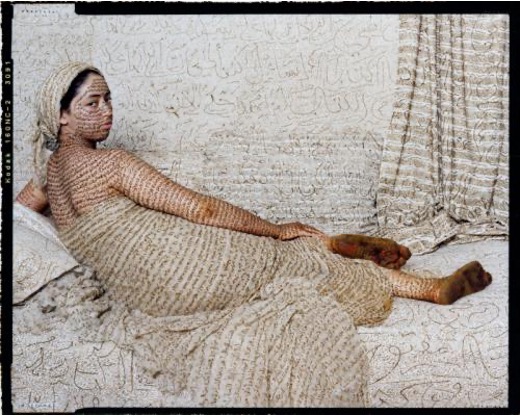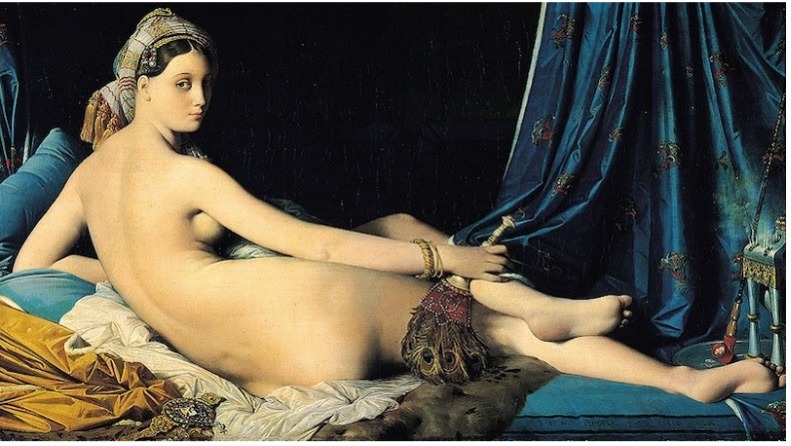Lalla Essaydi and Collage
GRADES 6-12
OBJECTIVES
After completing this activity, students will better be able to:
- Discuss and analyze representations of women in media and art
- Understand the concept of othering and discuss how othering happens in contemporary society
- Create a collage using images and text
BACKGROUND
Lalla Essaydi, is a Moroccan contemporary artist, primarily known for her carefully constructed photographs of women. Born in 1956, the artist spent her formative years in Marrakesh and eventually moved to the United States, where she studied painting and photography at the School of Museum of Fine Arts at Tufts University. Currently, the New-York based artist divides her time between Morocco and the United States.
Essaydi’s draws from her own cross-cultural experience to investigate the complex roles of Arab women in contemporary and past societies. Many of the artist’s staged photographs depict Arab women adorned with calligraphic Arabic script the artist applies in henna and set in spaces that have been historically reserved for women. This calligraphy is intentionally illegible, making it impossible to decipher. Integral to artist’s work is the iconography of Orientalist art. By subverting popular imagery found in Orientalist paintings, Essaydi draws attention to the fantasies and stereotypes embedded in depictions of North African, Middle Eastern, and Asian women. Some examples of Orientalist motifs Essaydi appropriates and deconstructs are the veil, harem, and odalisque.

Les Femmes Du Maroc: La Grande Odalisque
Lalla Essaydi (born 1956)
2008
photographic print, edition of 10
43 1/2 x 54 1/2 inches (110.5 x 138.4 cm)
2011.1

La Grande Odalisque
Jean-Auguste-Dominique Ingres
1814
Oil on canvas
36″ x 63″
Musée du Louvre, Paris
ESSENTIAL QUESTIONS
What is Orientalism?
What role did Orientalism play in “othering” Arab, North African, Asian women?
How can art challenge or deconstruct stereotypes
DISCUSSION QUESTIONS
- Look closely.
- What are stereotypes?
- What are some of the issues with stereotypes?
- How can images reinforce stereotypes?
- What stereotypical images of people would you like to change?
- How does Essaydi’s work challenge stereotypes of Arab women?
- How does Essaydi’s photograph compare to Ingres’ La Grande Odalisque? What did she change? What stayed the same?
- Why do you think the artist made these changes?
- Why do you think the artist chose to use text?
- Who do you think the women in these photographs are?
- What can their postures and facial expressions tell us about these women?
VOCABULARY
Collage – an art technique in which paper, photographs, and other materials are cut and combined to create a work of art
Orientalism – a 19th century European art movement, known for its depictions of people and places from North Africa, the Middle East, and Asia. Orientalists painters often mixed reality with fantasy, creating images that misrepresented these regions and the dozens of cultures found there as being hypersexual, barbaric, overly feminine, or exotic.
Henna – a temporary dye made from the henna plant that is used in Mehndi, an art form where henna is applied in decorative patterns directly to the skin
Odalisque – based on the Turkish word for chambermaid (odalık), odalisque was a term used in Europe to describe a female concubine or slave in a harem. Odalisques were a popular subject matter in Orientalist paintings.
Harem – a harem (or seraglio) is the apartments reserved for female members of a household. In the Ottoman Empire, these were the spaces where the wives, unmarried daughters, young sons, unmarried female relatives, mothers, female servants, and concubines of a ruler resided. This was a practice generally reserved for the upper classes, as men and women in poor communities did not typically have separate living quarters.
ACTIVITY
INSTRUCTIONS
- Before looking at art, have the students define what a “stereotype” is and have them discuss some of the issues with stereotypes.
- Briefly discuss the history of Orientalist painting before showing the student Jean-Auguste-Dominique Ingres’s La Grande Odalisqu (You can also show the students Jean-Léon Gérôme’s Bashi-Bazouk, Jean-Léon Gérôme’s Snake Charmer, Eugène Delacroix’s Women of Algiers in their Apartment (1834).
- Ask the students what these images tell us about places and people they depict and if they think the painting is depicting these places accurately. Use the discussion questions to support conversation.
- Show the students Lalla Essaydi’s work. Have them compare Essaydi’s work to Ingres’ and discuss why they think she choose to change the work.
- After comparing Essaydi and Ingres artworks, Students will use images from magazines to create a collage that changes a stereotype they often hear or see in popular culture.
- When they are finished, have students show their collages and discuss how their image challenges or deconstructs a stereotype.
- Magazines
- Mixed media paper
- Glue sticks
- Scissors
- Paint markers/sticks (optional)


